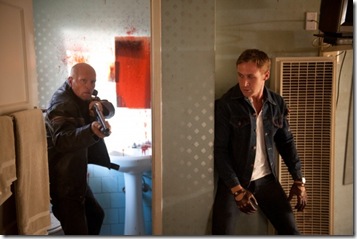Nicolas Winding Refn’s Drive is a strange beast. The ads make it look like an action/crime thriller, but it’s more a suspenseful noir-ish art film with occasional ultra-violent outbursts. Between Refn’s direction and Ryan Gosling’s performance in the lead, it is one of the oddest good films of the year.
I probably won’t be the only critic to suggest that Ryan Gosling’s character, Driver [that’s how he’s credited] owes something to Clint Eastwood’s Man With No Name. He’s quiet, tough and thorough. He’s smart, capable of great anger and equally great tenderness. He probably doesn’t have fifty lines of dialogue in the entire film. He even wears the same clothes throughout the film [instead of a serape, he sports a white bomber jacket with a gold scorpion on the back].
Driver makes his living driving – doing stunt work for the movies; providing the best in getaway driving for random robberies – and working on cars for his boss/agent, Shannon [Bryan Cranston]. Shannon has plans to get Driver into racing [stock cars] and enlists the financial aid of Bernie Rose [Albert Brooks] a movie producer turned crime boss.
There’s a girl, of course. There’s always a girl. Here, she’s Irene [Carey Mulligan], a waifish woman who lives two doors down from his apartment, with her cute but solemn son, Benicio [Kaden Leos]. She also has a husband in prison, Standard [Oscar Isaac], whom she doesn’t mention until he’s about to be let out.
Nicolas Winding Refn has built up a cult following through films like the weird Viking epic Valhalla Rising and gonzo crime film Bronson. With Drive, he takes his Scandinavian sensibility and melds it with the American noir to create a compelling film that gets under one’s skin with its tension before a very few [and therefore even more unnerving] explosions of violence that are so beautifully timed that I jumped every single time – even when I expected something to happen.
Refn gets an unusual performance from Gosling. Not only does he not speak much, he barely exhibits any facial expressions at all [except for one particularly violent sequence] – and yet [and in this, he reminds me of the late James Mason], every emotion he feels is supremely evident.
Mulligan is far more open and vulnerable as Irene, and is completely convincing as the young mother who falls for Driver, and in so doing, sets in motion a series of actions and consequences that have unexpectedly devastating consequences.
The film’s biggest revelation, though, is Brooks’ darkly amiable gangster boss. To say he gets his hands dirty is such an understatement – and to see Brooks explode the way he does… it’s purely chilling.
There’s a ‘one last job’ sequence, too, that goes sideways in the extreme, that includes Standard and a tough redhead called Blanche [Christina Hendricks]. Another cool thing: Ron Perlman pops up as Bernie’s wild card partner, Nino.
When you put together the moody lighting [a lot of the film takes place at night], Dutch angles [what’s a noir without Dutch angles?], the suspense [complemented by a fine score that uses a lot of electronica] and a set of sterling performances, you get a hugely entertaining film that is neither an art film nor a classic noir, but an unexpected hybrid of the two.
Final Grade: A
